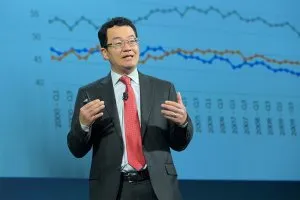By Gary Fineout
DOT, HUD and EPA form a new, unique relationship under the Livable Communities Initiative
It may be just a fledging partnership, but a unique arrangement among three federal agencies could set the stage for a concentrated focus on creating sustainable communities that aim to improve the environment, provide access to affordable housing and offer residents low-cost transportation.
“I would say that the goal of the partnership is to make the creation of communities that have sustainable characteristics the commonplace style of development in this country, rather than the exception,” explains John Frece, head of the Smart Growth Office of the United States Environmental Protection Agency.
The Sustainable Communities partnership was forged among the EPA, the Department of Transportation and the U.S. Department of Housing and Urban Development shortly after President Barack Obama took office in 2009. It started as an agreement between DOT and HUD to do joint initiatives on housing and transportation, but over the summer, EPA has also joined the partnership.
Frece, who had been the associate director of the University of Maryland’s Center for Smart Growth Research before going to work for EPA, views the partnership as a significant shift in the U.S. government’s attitude toward smart growth.
“The smart growth program has been working on these issues since 1996,” said Frece. “What has changed in the past four or five months is that I think the federal government has gone from a point where we were one of the few offices looking at this to one of many agencies looking at these issues.”
The partnership has some broad goals outlined in its agreement, which include: provide more transportation choices, promote equitable and affordable housing, support existing communities, increase access to economic opportunities and align policies and funding among the three agencies to support the effort.
Other key elements of the agreement call for redefining housing affordability measures so that they include transportation costs, redeveloping underutilized sites and performing research to develop a way to evaluate the livability of communities.
EPA Administrator Lisa Jackson — who testified about the partnership before Congress — said the idea is that these goals would wind up emphasizing developments that use less land and energy, provide affordable housing to people of all income and stages of life, make it easier for people to get to their destinations on foot, bike or public transit and direct growth to developed areas.
Jackson acknowledged that while there is a debate about the “appropriate federal role” in land use decisions, it’s also apparent that federal decisions can influence development patterns. She said the federal government has an “obligation” to “ensure our actions do not favor development that adversely affects the environment and public health.”
“If we are smarter about how we grow, we can make America’s big cities, small towns and rural communities more resilient to the economic and environmental challenges facing America,” she said.
The ramifications of the partnership aren’t entirely clear yet as all three agencies are working on an action plan intended to carry out the goals. Frece pointed out, however, that the goals will become imbedded in the legislative and regulatory actions of the three agencies who are now meeting weekly to discuss the initiative.
And Frece notes that one effort that has already begun is to identify conflicting federal policies that are “barriers” to carrying out the goals of the partnership. One of the barriers that has been removed is a prohibition that kept HUD from investing in multi-family housing projects built on brownfields.
“There are properties across the country with good access to affordable transportation and jobs that could be developed into affordable housing but aren’t developed because of the federal red tape involved,” said HUD Secretary Shaun Donovan when he announced the policy change.
But Frece cautioned that the first goal of looking at the barriers is “first do no harm.”
The partnership will also influence how the federal government hands out grants and other assistance to cities and counties across the country.
The top officials at all three agencies this fall toured Chicago, Denver and Dubuque, Iowa where they looked at developments that met the sustainable communities goals. During the visit to Denver, Donovan announced his agency was awarding $300 million in money from the American Recovery and Reinvestment Act to fund 36 “green” public housing transformation projects across the country. One $10 million grant was going to the Denver Housing Authority to continue development of South Lincoln Park Homes, which is located next to a light rail stop and built on a formerly contaminated brownfield site.
These grants are designated for the substantial rehabilitation or new construction of public housing developments that will increase energy efficiency and environmental performance. The idea is to reduce energy costs, generate savings for residents and reduce greenhouse gas emissions. The 36 projects that received money were spread out across the country from Miami to Alexandria, La.; Rome, Ga.; El Paso, Texas and Seattle.
EPA announced in September that it would pay for technical assistance grants to the state of California, the cities of Las Cruces, N.M., Louisville, Ky., and Montgomery County, Md. that would bring together agency staff and experts to help with sustainability efforts. EPA also unveiled a new tool to help local governments identify specific zoning code and land ordinance fixes that would improve access to affordable housing, provide additional low-cost transportation options, preserve community character and protect the environment.
EPA also plans to launch an urban waters initiative in connection with HUD and DOT to help urban communities revitalize their waterways and restore neighboring communities. The environmental agency also wants additional funding to boost its clean water program that offers financial assistance to improve aging wastewater and storm water systems.
Frece said that the billions spent on water improvements can influence where growth occurs.
DOT Secretary Ray LaHood said in June that his agency planned to award $1.5 billion in Transportation Investment Generating Economic Recovery (TIGER) grants by early 2010. LaHood said that projects that promote greater mobility, a cleaner environment and a more livable community would receive priority over other projects.
HUD Secretary Donovan — who appeared jointly before Congress with LaHood and EPA Administrator Jackson— said targeting affordable housing projects that feature reduced transportation costs is not only good for the environment, but it makes economic sense.
“The connection between transportation options and home values is clear,” Donovan told Congress. “As the recent housing downturn has shown, auto dependent houses — or homes that virtually require the resident to have access to a car — are more vulnerable to price devaluation. Homes in distant or remote neighborhoods showed a greater decline in value, while some centrally-located homes held or increased their value compared to regional averages.”
Frece says research done by EPA and private firms shows that there is a great deal of demand for sustainable communities that isn’t being met right now. He says that changing demographics — from aging baby boomers desirous of being close to entertainment and healthcare to young people without children — are creating a desire for places to live that are walkable and have amenities nearby.
“There’s a big gap between the demand and what’s out there,” said Frece.
Gary Fineout is an award-winning journalist who covered politics and government for nearly 20 years. He previously worked in the Tallahassee bureau of The Miami Herald and his work has also appeared in The New York Times and several other Florida newspapers. He is now an independent journalist.








